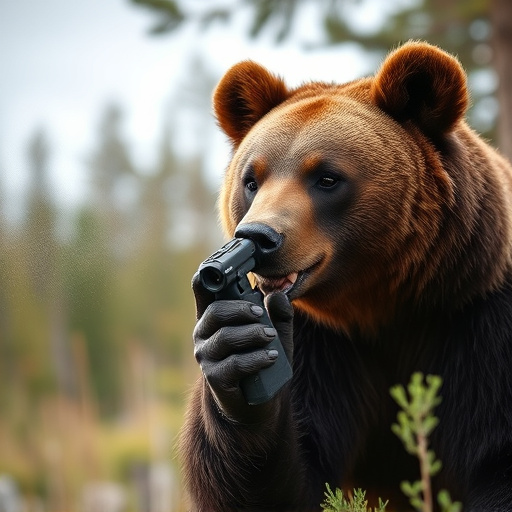Bear spray, a chili pepper-based deterrent, requires careful selection, proper application techniques, regular maintenance, and adherence to Bear Spray Testing Safety Guidelines for effective use against aggressive bears in their natural habitats. Key considerations include regional bear species, equipment design with strong spray reach, durability, non-toxic ingredients, thorough testing, controlled storage, and continuous user training for safe deployment at close range (20-30 feet) during bear encounters. Following these guidelines ensures reliability and minimizes risk while maximizing the spray's effectiveness in deterring bear attacks.
Bear attacks are a serious concern for outdoor enthusiasts and those living in bear country. One effective tool to deter these formidable predators is bear attack prevention spray, commonly known as bear spray. This article delves into the essential aspects of bear spray equipment, offering insights on understanding its composition and effectiveness, selecting the right gear, proper application techniques, storage, and safety guidelines for testing and user training. By following these key points, you can enhance your safety in potential bear encounters.
- Understanding Bear Spray: Composition and Effectiveness
- Selection Criteria for Bear Attack Prevention Spray Equipment
- Application Techniques and Timing: Maximizing Safety
- Storage and Maintenance: Ensuring Longevity and Reliability
- Safety Guidelines for Testing and User Training
Understanding Bear Spray: Composition and Effectiveness
Bear spray, also known as bear defence spray, is a specialised pepper spray designed to deter and protect against bears during encounters in their natural habitats. The primary active ingredient in most bear sprays is capsaicin, derived from chili peppers. This compound irritates the eyes, nose, and respiratory system of bears, temporarily disorienting them and providing humans with an escape opportunity.
When using bear spray, it’s crucial to follow safety guidelines outlined by manufacturers and testing agencies. Bear spray testing involves rigorous evaluations to ensure its effectiveness under various conditions. These tests include assessing spray patterns, distance range, and the impact on different bear species. Proper usage involves aiming for the bear’s face and eyes while keeping a safe distance, typically around 20-30 feet (6-9 metres). Regular maintenance and checking of expiration dates are essential to guarantee the spray remains potent when needed.
Selection Criteria for Bear Attack Prevention Spray Equipment
When selecting bear attack prevention spray equipment, several key factors come into play. It’s crucial to consider the specific type of bears in your region, as different species vary in size, behavior, and sensitivity to spray irritants. For instance, black bears may require a milder formula than grizzly or polar bears. Bear spray testing safety guidelines should be followed rigorously; these tests ensure the product’s effectiveness against attacks while minimizing risk to users.
Additionally, the range and potency of the spray matter greatly. Look for equipment with a proven track record in deterring bears, offering a strong spray that reaches recommended distances. Safety features such as easy application mechanisms, durable design, and non-toxic ingredients are essential to ensure user safety during encounters. Always refer to Bear Spray Testing Safety Guidelines to guarantee you’re acquiring a reliable product capable of preventing bear attacks effectively.
Application Techniques and Timing: Maximizing Safety
Effective bear spray application involves mastering specific techniques and timing to ensure safety. Before encountering a bear, users should conduct thorough Bear Spray Testing following established Safety Guidelines. This includes ensuring proper grip and aiming for the bear’s face and eyes—the primary sensory organs.
Timing is critical; deploying the spray at close range (ideal distance 20-30 feet) when a bear shows aggressive behavior or approaches aggressively allows for maximum efficacy. Proper application creates a barrier, temporarily blinding and disorienting the bear, providing precious escape time. Regular practice sessions are crucial to becoming proficient in these techniques, enhancing the likelihood of safe escape during an actual encounter.
Storage and Maintenance: Ensuring Longevity and Reliability
Proper storage and regular maintenance are key factors in ensuring the longevity and reliability of bear attack prevention spray equipment. It’s crucial to store the spray in a cool, dry place, away from direct sunlight and extreme temperatures. Keep it out of reach of children and unauthorized individuals for safety guidelines to be effective. Regularly inspect the spray for any signs of damage, leakage, or expiration, as these can compromise its effectiveness.
Follow the manufacturer’s recommended maintenance schedule, which may include periodic cleaning, checking the nozzle for blockages, and ensuring the pressure is within the optimal range. Bear spray testing should be conducted regularly to verify its performance and ensure it remains potent and ready for use in case of an emergency. Adhering to these safety guidelines will maximize the reliability of your bear attack prevention spray during encounters in wild environments.
Safety Guidelines for Testing and User Training
When it comes to bear spray testing and user training, adhering to safety guidelines is paramount. Before conducting any tests, ensure a safe and controlled environment free from any potential hazards or bystanders. Use designated testing areas away from public spaces and wildlife habitats. Only trained professionals should handle and test the equipment to prevent accidents and injuries.
Proper training for users is essential. Educate individuals on how to correctly hold, operate, and deploy the bear spray. Practice scenarios should simulate real-life situations to ensure users are prepared. Teach them about the spray’s range, effectiveness, and safety measures post-use. Regular refreshers and scenario-based drills can help maintain proficiency and ensure user confidence when facing potential bear encounters.
Bear spray is a valuable tool for preventing attacks, but proper usage and maintenance are key. Adhering to safety guidelines during testing and ensuring user training will maximize its effectiveness. Regular storage and upkeep are essential to guarantee the reliability of your bear attack prevention spray equipment. By understanding composition, selection, application, and safety protocols, individuals can better protect themselves in bear country. Remember, knowing how to use bear spray responsibly is a crucial step in navigating potential encounters safely.
